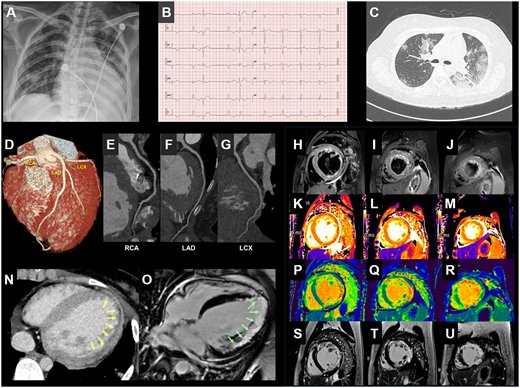South Korea reported over the weekend the first case of a heart disease linked to novel coronavirus infection, suggesting the virus most commonly known to cause respiratory distress may have a wider spectrum of complications.
In Daegu, Korea’s worst affected city with 64 percent of the total virus tally, a 21-year-old woman without preexisting medical conditions suffered an acute myocarditis from COVID-19.
The young patient initially exhibited typical symptoms of the virus including a cough, sore throat, fever and diarrhea when she was confirmed as a mild case in late February, said cardiologist Dr. Kim In-cheol, who treated her.
But around three days after being diagnosed, she started experiencing worsening breathing difficulties and had to be taken to the intensive care unit of Keimyung University Dongsan Hospital -- a coronavirus-only hospital for severely or critically ill patients.
MRI, X-ray and CT imaging of her chest showed signs of infections in the lungs as well as the heart, Kim said in a phone interview.
“Her chest scans revealed an enlarged heart and patterns of viral pneumonia, such as ground-glass opacities,” he said.
Her cardiac size -- less than 50 percent of the thorax in a healthy person -- was estimated to be about 65 percent, he said, explaining the disproportionate cardiothoracic ratio meant the heart’s ability to pump blood had been compromised.
She was hospitalized for a month, about a fourth of which was spent in intensive care. Although she has since recovered, the extent of cardiac damage from the virus may prove lasting, he said.
At his hospital where more serious COVID-19 patients are treated, close to half demonstrated signs of heart damage. The fatality rate was also higher for patients who developed heart issues.
Highly sensitive methods of testing including scanning levels of a protein called troponin in the blood -- a biomarker of a myocardial injury -- were used to detect heart damage in patients, he said.
“People with heart conditions are at increased risk of a severe COVID-19 infection,” he said.
There are three main ways the coronavirus can provoke heart injury, according to Kim.
First is when patients have low oxygen levels in the blood, or hypoxia. The lung capacity for trading carbon dioxide for oxygen becomes diminished, leading to heart muscle injury.
Second is an extreme immune response known as cytokine storm, which may end up damaging healthy tissue including that in the heart.
Lastly, the coronavirus could attack the heart muscle directly by binding to receptors known as the ACE2 in heart cells.
Infectious disease specialist Dr. Kim Woo-joo of Korea University Hospital in Guro, southern Seoul, said the new virus entered human cells by latching onto the ACE2.
The entry receptors are found not only in the lungs, but also in the kidneys, gastrointestinal tract and heart -- which is why the SARS-CoV-2, the virus responsible for COVID-19, is capable of causing inflammation in organs other than the lungs, he explained.
“In the worst of cases, a patient dies from multi-organ system failure after developing not just pneumonia but heart, kidney, gastrointestinal problems,” he said.
Another infectious disease expert, Dr. Kim Tae Hyong of Soonchunhyang University Hospital in central Seoul said the viral myocarditis associated with COVID-19 was “not a new discovery.”
“Respiratory viruses such as the influenza can induce cardiac issues in patients,” he said.
Still, the COVID-19 symptoms were chiefly present within the respiratory system, he said, and it was unclear whether the virus was more virulent towards the heart.
Asked if certain age groups were more vulnerable to the viral heart infections, he said, “The virus does not discriminate based on age -- it affects the young and old alike.”
By Kim Arin (
arin@heraldcorp.com)






![[Herald Interview] How Gopizza got big in India](http://res.heraldm.com/phpwas/restmb_idxmake.php?idx=644&simg=/content/image/2024/11/20/20241120050057_0.jpg)

